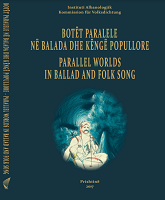UNAWAKENING FROM THE DREAM OF DEATH: PARALLEL WORLDS OF FOLK TRADITION IN MACUSHLA
UNAWAKENING FROM THE DREAM OF DEATH: PARALLEL WORLDS OF FOLK TRADITION IN MACUSHLA
Author(s): James I. Deutsch
Subject(s): Customs / Folklore, Music, Pre-WW I & WW I (1900 -1919)
Published by: Instituti Albanologjik i Prishtinës
Keywords: Macushla; Irish Song; Lyrics; Million Dollar Baby; Motif of Resurrection;
Summary/Abstract: The lyrics to the popular song ‘Macushla’ were written by Josephine V. Rowe, with music composed by Harold Robert White (writing under the pseudonym of Dermot MacMurrough) in 1910. The song became an immediate hit when the great Irish tenor John McCormack recorded it for the Victor Talking Machine Company in 1911. Although ‘Macushla’ is not a traditional ballad itself, it may be regarded as ballad-like in the story it tells, the imagery it evokes, and the traditional motifs it employs. The singer is calling out to someone who is either dead or in a deep dream-like sleep resembling death, which may be seen as a parallel world or alternate reality. Nearly ninety years later, elements of ‘Macushla’ reappeared in a short story, ‘Million $$$ Baby’ (2000), written by Jerry Boyd (using the nom de plume of F.X. Toole), which was adapted by screenwriter Paul Haggis for the Academy Award-winning film Million Dollar Baby (2004), directed by Clint Eastwood. Boxer Maggie Fitzgerald, the titular Million Dollar Baby, is nicknamed Macushla or Mo Cuishle before she enters a parallel world when paralyzed due to a severe spinal cord injury sustained in the ring. Although Irish folk tradition often invokes sorrow and the violation of expectations, popular Hollywood films rarely do so—preferring more upbeat endings that do not disturb the expectations of their audiences. The representations of alternate realities and parallel worlds in ‘Macushla,’ ‘Million $$$ Baby,’ and Million Dollar Baby tellingly demonstrate the continuing presence of a traditional past in popular film, song, and literature.
Book: BOTËT PARALELE NË BALADA DHE KËNGË POPULLORE
- Page Range: 401-420
- Page Count: 20
- Publication Year: 2017
- Language: English
- Content File-PDF

